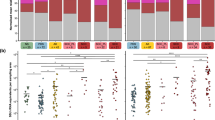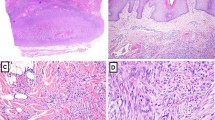Abstract
Desmosomes are intercellular junctions that have been shown to be down-regulated in certain types of carcinoma and that may play a role in suppression of invasion and metastasis. This paper describes an immunohistochemical study of three types of epidermal neoplasms with monoclonal antibody to desmoglein in order to determine how desmosomal staining correlates with the clinical, biological and histopathological features of these neoplasms. Actinic keratosis (AK) is the most common keratinocytic premalignant neoplasm that was reported to have a 10-20% rate of malignant transformation into squamous cell carcinoma (SCC). Keratoacanthoma (KA) is a benign neoplasm that involutes spontaneously after a few months of rapid growth. SCC is a malignant tumour capable of metastasis. Electron microscope studies of KA and SCC showed significantly reduced staining for desmosomes in SCC but not in KA. We have examined staining for desmoglein using the monoclonal antibody 33-3D, a mouse IgM monoclonal antibody, that recognizes the cytoplasmic domains of desmoglein (Dsg)1 and Dsg2 on frozen sections. Immunohistochemical staining of normal skin with this antibody revealed strong pericellular localization of the antigen, outlining the cell membranes of the keratinocytes. A series of 30 AKs, 12 KAs and 24 SCCs was stained immunohistochemically with 33-3D monoclonal antibody. All examined KAs showed extensive pericellular staining for Dsg. By contrast, juxtanuclear staining for Dsg was noted in 12 SCCs, and completely negative staining in seven SCCs. The five remaining SCCs showed focal pericellular staining for the Dsg marker. The most common finding in AK was focal pericellular staining for Dsg, with complete absence of staining in dysplastic areas (25 cases). In five cases negative pericellular staining in dysplastic areas was associated with juxtanuclear accumulation of the Dsg marker. A strong negative correlation between Dsg staining and degree of dysplasia was obtained. The Dsg pattern in KA is similar to normal epidermis and shows a clear difference between KA and SCC. AK has a limited loss of Dsg expression in a SCC-like pattern that is congruent with its premalignant nature. As the stain works on frozen tissue, it may be helpful for rapid differentiation in selected cases in cutaneous oncology and Mohs micrographic surgery. This antibody may also have great potential for the detection of the effects of chemopreventive agents in skin cancer.
This is a preview of subscription content, access via your institution
Access options
Subscribe to this journal
Receive 24 print issues and online access
$259.00 per year
only $10.79 per issue
Buy this article
- Purchase on Springer Link
- Instant access to full article PDF
Prices may be subject to local taxes which are calculated during checkout
Similar content being viewed by others
Author information
Authors and Affiliations
Rights and permissions
About this article
Cite this article
Krunic, A., Garrod, D., Madani, S. et al. Immunohistochemical staining for desmogleins 1 and 2 in keratinocytic neoplasms with squamous phenotype: actinic keratosis, keratoacanthoma and squamous cell carcinoma of the skin. Br J Cancer 77, 1275–1279 (1998). https://doi.org/10.1038/bjc.1998.213
Issue Date:
DOI: https://doi.org/10.1038/bjc.1998.213
This article is cited by
-
A six-gene expression signature related to angiolymphatic invasion is associated with poor survival in laryngeal squamous cell carcinoma
European Archives of Oto-Rhino-Laryngology (2021)
-
Plakophilin 1 enhances MYC translation, promoting squamous cell lung cancer
Oncogene (2020)
-
Identification of candidate aberrantly methylated and differentially expressed genes in Esophageal squamous cell carcinoma
Scientific Reports (2020)
-
Expression of Cyclooxygenase-2 in Squamous Cell Carcinoma and Keratoacanthoma and its Clinical Significance
Cell Biochemistry and Biophysics (2015)
-
Study of MDM2 and SUMO-1 expression in actinic cheilitis and lip cancer
Archives of Dermatological Research (2014)



